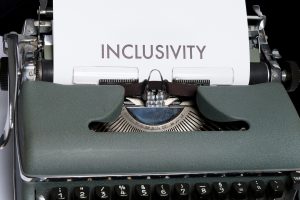Foster an Inclusive Learning Environment
Examine your assumptions.
It is very common for instructors to assume that student shares their own background, but this is not necessarily so. Do you find yourself addressing students as if they all share your social identities?
Learn and use students’ names.
When replying to discussion posts or providing paper feedback, always address students by name.
Model inclusive language.
For instance, avoid using masculine pronouns for both males and females. For example “Good Morning, guys!”
Use multiple and diverse examples.
Multiple examples increase the likelihood of students relating to at least one of them. Take care to include examples that speak to both sexes and that work across cultures.
Establish ground rules for interaction.
This will assure that other students are also being inclusive and respectful. It is important to allow students to voice their opinions, but setting guidelines to do so safely and respectfully is key.
Examine your curriculum.
Are certain perspectives systematically not represented in your course materials (e.g., a course on family focusing only on traditional families, or a course on public policy ignoring race issues)? If you notice any issues, please reach out to your Program Director.
Be mindful of low ability cues.
In their efforts to help students, some instructors inadvertently send mixed messages (e.g., “Sure, I’ll be happy to help you with this, I know girls have trouble with math”). These cues encourage gender bias and promote stereotypes. Instead, it is more productive to focus on controllable causes, such as effort.
Provide accommodations for students with disabilities.
Every instructor will be notified of any student needing accommodations prior to the start of your course. Be sure to make note and ensure the guidelines are appropriately followed as this is required by law.
Don’t ask people to speak for an entire group.
Students of underrepresented identities often report either feeling invisible in class or sticking out like a sore thumb as the token member. This experience is heightened when they are addressed as spokespeople for their whole group and can have implications on performance.
Gender Inclusivity
Please remember that there may be students enrolled in your courses who do not identify as women or express femininity. Fully embracing our identity as a women’s college means we are committed to developing inclusive and safe learning communities for all students, regardless of gender expression or identity. We expect our faculty to cultivate understanding and acceptance of gender diversity within their classrooms, and foster equitable learning spaces that do not marginalize trans women, trans men, and non-binary individuals who have been admitted to and/or graduated from Bay Path University. With these commitments in mind, we encourage the use of gender-neutral language while teaching and expect that all students’ names, pronouns, gender identities, and gender expressions will be honored by faculty and classmates.
Additional Resources
This brief article defines culture and culturally responsive teaching. It provides recommendations on how to apply culturally responsive teaching through relationship development, curriculum design, and delivery of content.
This brief article highlights the benefits of inclusivity and diversity in the classroom. The article also outlines steps that an educator can take to foster an inclusive classroom environment.
This blog, featured on Pearson’s website, also highlights the many benefits of an inclusive classroom, and provides educators with practical strategies to encourage and celebrate diversity in their classrooms.
Take this free, self-paced training course through Cornell Open Learning. This course focuses on exploring your formative experiences as a learner, teacher, and member of a discipline; strategies and exercises helpful in communicating effectively, facilitating discussion, and modeling inclusivity when unexpected issues arise; and research, frameworks, and models that help us understand why and how diversity and inclusion matter in teaching and learning.
This brief article outlines some practical strategies to cultivate an inclusive classroom environment. Check out the references section for lots of great links to additional resources and research!
- Read: Gender Pronouns [6]
This website provides an explanation of gender pronouns and explains why they are important,
The TAWC academic team is focusing on goals related to equity and antiracism in our curricula and pedagogical practices. This reflective session [32:30] will focus on what steps are already being taken, and how we can continue to take tangible steps toward achieving these goals by inviting discussion on the following questions: How can we empower our instructors and ourselves to critique personal and institutional systems, biases, values, and pedagogies? In what ways are racism and white supremacy perpetuated in the tools, systems, and practices we use for accelerated online teaching and learning? How can we foster equitable and antiracist accelerated online learning spaces?
- Richardson, C. (n.d.). Teaching and learning conversation (TLC): Culturally responsive teaching. University of Delaware Center for Teaching and Assessment of Learning. Retrieved from https://cpb-us-w2.wpmucdn.com/sites.udel.edu/dist/c/6655/files/2014/03/Culturally-Responsive-Teaching-1jy7hnk.pdf (Links to an external site.). ↵
- American University. (2019, July 24). The benefits of inclusion and diversity in the classroom. American University School of Education. Retrieved from https://soeonline.american.edu/blog/benefits-of-inclusion-and-diversity-in-the-classroom (Links to an external site.). ↵
- Hollister, D. (2020, June 10). Diversity and inclusion in the online classroom. Pearson. Retrieved from https://www.pearson.com/ped-blogs/blogs/2020/06/diversity-inclusion-in-the-online-classroom.html (Links to an external site.). ↵
- Cornell University. (n.d.). Teaching & learning in the diverse classroom. Retrieved from https://www.edx.org/course/teaching-learning-in-the-diverse-classroom. ↵
- Center for Teaching Excellence. (n.d.). Inclusivity in the classroom. University of Florida. Retrieved from https://teach.ufl.edu/resource-library/inclusivity-in-the-classroom/ (Links to an external site.). ↵
- Walden University. (2021). Diversity and inclusion: Gender pronouns. Retrieved from https://academicguides.waldenu.edu/diversity-inclusion/pronouns (Links to an external site.). ↵
- Online Learning. (2020, September 29). Antiracist and equity minded teaching. [Video File]. Retrieved from https://youtu.be/H0IMVsDuaVQ ↵
- Inclusive learning environment strategies . https://www.celt.iastate.edu/teaching/creating-an-inclusive-classroom/creating-an-inclusive-learning-environment/ ↵
